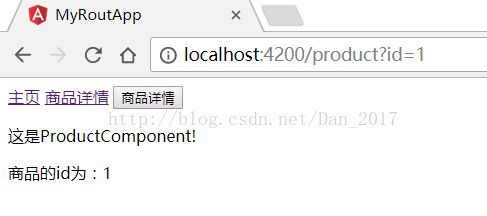Angular4笔记(二)
(一)路由介绍:
1:几个关键词的简介
2:每个关键词应该用到的地方
3:一个简单路由的配置,实现的效果如图
1:先生成两个组件(Home,Product)
2:app-routing.module.ts(这个文件在你创建项目的时候后面加一个参数 -routing 例如:ng new myAngular -routing)
import { NgModule } from '@angular/core';
import { Routes, RouterModule } from '@angular/router';
import { HomeComponent } from './home/home.component';
import { ProductComponent } from './product/product.component';
import { Code404Component } from './code404/code404.component';
//Routes:这里是根路由
const routes: Routes = [
//path:指路由的路径。component:指路由的目标组件
{ path:'' , component:HomeComponent},
{ path:'product' , component:ProductComponent},
//这里配置的是一个页面不存在的路由
{ path:'**' , component:Code404Component},
];
@NgModule({
imports: [RouterModule.forRoot(routes)],
exports: [RouterModule]
})
export class AppRoutingModule {
constructor(){
}
}
app.component.html
主页
商品详情
home.component.html
这是HomeComponent!
product.component.html
这是ProductComponent!
(二)路由传递参数
路由传递参数(1:在查询参数中传递参数 2:在路由路径中传递参数)
1:在查询参数中传递参数
app.component.html 以queryParams传递参数
<-- 1:用参数来传递商品属性的值。queryParams传递参数id的值为1-->
商品详情import { Component, OnInit } from '@angular/core';
import { ActivatedRoute } from '@angular/router';
import { Params } from '@angular/router/src/shared';
@Component({
selector: 'app-product',
templateUrl: './product.component.html',
styleUrls: ['./product.component.css']
})
export class ProductComponent implements OnInit {
private productId:number;
constructor(private routeInfo:ActivatedRoute) {
}
ngOnInit() {
// 1:接受以路由参数传过来的参数,ActivatedRoute当前激活的路由对象,可以获取路由地址,以及路由参数
this.productId=this.routeInfo.snapshot.queryParams["id"];
}
}
商品的id为:{{productId}}
2:在路由路径中传递参数 (主要是传递和接收和上一种方式不一样,其他都一样)
app-routing.module.ts文件修改path
//2:以URL的方式传商品属性的值
{ path:'product/:id' , component:ProductComponent}, this.productId=this.routeInfo.snapshot.params["id"];app.component.html商品详情
参数快照和参数定略(注:当一个路由从自身路由到自身使用参数定略的方式,反之参数快照的方式)
// 1:参数快照方式。由于OnInit()在组件创建的时候只执行一次,所以第二次获取商品id的时候还是第一次传过来的值
this.productId=this.routeInfo.snapshot.params["id"];
//2:参数定略方式(完美的解决了参数快照的问题)。this.routeInfo.params.subscribe会获得一个params的值然后把params["id"]赋值给productId
this.routeInfo.params.subscribe((params:Params)=>this.productId=params["id"]);(三)路由重定向
//路由重定向:当''路由过来时先重定向到/home然后在到home
{path:'',redirectTo:'/home',pathMatch:'full'},
//path:指路由的路径。component:指路由的目标组件
{ path:'home' , component:HomeComponent},



